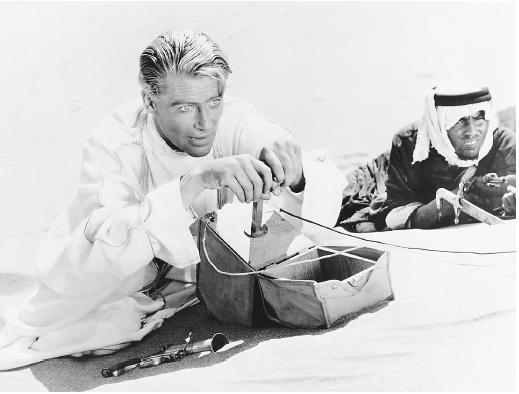Lawrence Of Arabia - Film (Movie) Plot and Review
UK, 1962
Director: David Lean
Production: Horizon Pictures; color, Super-Panavision 35mm; running time: 222 minutes. Director's cut released 1989.
Producer: Sam Spiegel; screenplay: Robert Bolt, Michael Wilson; photography: Freddie Young; second unit photography: Nicolas Roeg, Skeets Kelly, Peter Newbrook; editor: Anne V. Oates; assistant director: Roy Stevens; production designer: John Box; art directors: John Stoll, John Box; music: Maurice Jarre; sound editor: Winston Ryder; sound recording: Paddy Cunningham.
Cast: Peter O'Toole ( Lawrence ); Omar Sharif ( Sherif Ali ); Anthony Quinn ( Auda Abu Tayi ); Alec Guinness ( Prince Feisal ); Jack Hawkins ( General Allenby ); Jose Ferrer ( Turkish Bey ); Anthony Quayle ( Colonel Brighton ); Claude Rains ( Mr. Dryden ); Arthur Kennedy ( Jackson Bentley ); Donald Wolfit ( General Murray ).
Awards: Oscars for Best Picture, Best Director, Best Photography, Best Score, Best Editing, Best Art Direction, Best Sound, 1962.
Publications
Books:
Pratley, G., The Cinema of David Lean , New York, 1974.
Silver, Alain, and James Ursini, David Lean and His Films , New York, 1974.
Anderegg, M.A., David Lean , Boston 1984.
Wapshott, Nicholas, Peter O'Toole: A Biography , New York, 1984.
Silverman, S.M., David Lean , New York, 1989, 1992.
Morris, R.L., and Lawrence Raskin, Lawrence of Arabia: The 30th Anniversary Pictorial History , New York, 1992.
Hodson, Joel C., Lawrence of Arabia & American Culture: The Making of a Transatlantic Legend , Westport, 1995.
Brownlow, Kevin, David Lean , New York, 1997.
Caton, Steven C., Lawrence of Arabia: A Film's Anthropology , Berkeley, 1999.
Articles:
Barra, A., "The Incredible Shrinking Epic," in American Film (Washington D.C.), March 1989.
Frumkes. R., "The Restoration of Lawrence of Arabia," in Films in Review (New York), April and May 1989.
Solman, G., "Uncertain Glory," in Film Comment (New York), May-June 1993.
Caron, A., in Séquences (Montreal), June 1989.
Combs, R., in Monthly Film Bulletin (London), June 1989.
Benayoun, R., "The Long Last Cut," in Positif (Paris), July-August 1989.
Gauthier, G., in Revue du Cinéma (Paris), July-August 1989.
Crowdus, G., in Cineaste (New York), 1989.
Bohne, L., "Leaning toward the Past," in Film Criticism (Meadville, Pennsylvania), Fall 1990.
* * *
Lawrence of Arabia has been described as a "thinking man's epic." The film has all the ingredients of a classic adventure yarn. Typically in epics, these ingredients are showcased to the detriment of character and plot in order to keep the action rolling. But in David Lean's epic, the title character and the political machinations surrounding his exploits take center stage; what's more, he remains an enigma even as the final credits fade to black.
Like the vast, arid landscape that, in the words of Alec Guinness's Prince Feisel, proves such a mystical allure for this latest in a line of "desert-loving Englishmen," the mystery of Lawrence's character is never quite fathomed. There is no Rosebud here. Even his rape at the hands of the Turks, which Lawrence described in his memoirs as the key assault on "the citadel of my integrity" and which may or may not have revealed to him a latent homosexuality, explains nothing.
The film overwhelms with its images of the desert and men at war, but the uncompromising genius of Lean's direction, Robert Bolt's screenplay and Peter O'Toole's starmaking performance as the obscure British map maker who becomes a national hero only to flee back to obscurity is that the focus always remains on the quest for

Lawrence of Arabia appeared at a time when the British cinema that produced it and Lean were taking a decidedly different turn. Lean began his career as an editor then director of small, mostly black and white, dramas about English life drawn from the works of Charles Dickens and Noel Coward. He established himself a master of the epic with The Bridge on the River Kwai (1957), the superlative World War II adventure film that won a slew of Oscars, including one for him as Best Director.
He began preparing Lawrence in 1960 when the foundering British film industry was being reshaped by a younger generation of filmmakers who scorned Lean's classically trained approach to narrative moviemaking and fondness for large scale canvases and subjects. They preferred to train their cameras not on vast landscapes and enigmatic heroes but on working class anti-heroes and the dreariness of British lower class life. Their small, black and white "kitchen sink" dramas, not Lean's behemoth tales of romantic characters swept up in the turbulence of historical events, were the future of British films, they maintained.
After the success of Lawrence , which took longer to make than it took the events the film chronicled to take place, Lean continued to invite scorn by making epics. When Lawrence was restored for re-release in 1989, he explained why. He'd envisioned a future when the astronomical costs of making such movies would eventually become prohibitive, so he made them while he had the chance. But there was more to it. As the curtains opened on the giant 70mm screen at the London premiere of the restored Lawrence , the ailing director, speaking on audio tape, invited the audience to sit back and experience "what the movies used to be"—i.e. something that could not be experienced the same way except at the movies.
His younger colleagues' "kitchen sink" dramas and even his own earlier films in a similar vein could be shown on television with no loss in emotional effect. But not the epic, and certainly not Lawrence . For him a film like Lawrence of Arabia was what cinema in the post-TV era was all about: a grand opportunity for larger than life adventure, in both the making of it and the seeing of it, that should be seized upon if for no other reason than the unlikelihood of it ever coming our way again.
—John McCarty
Comment about this article, ask questions, or add new information about this topic: